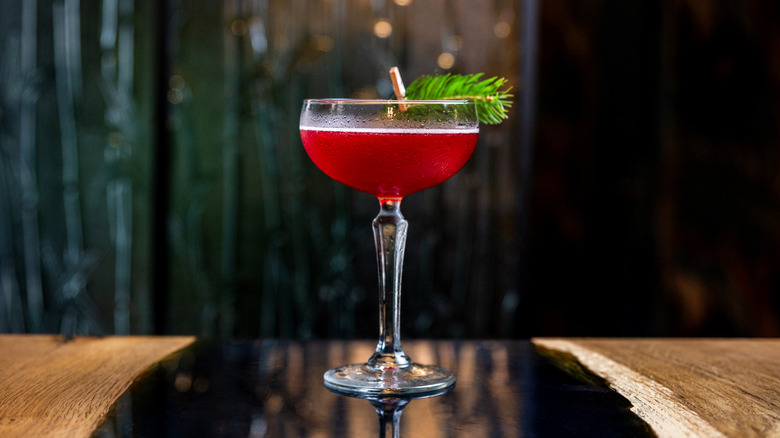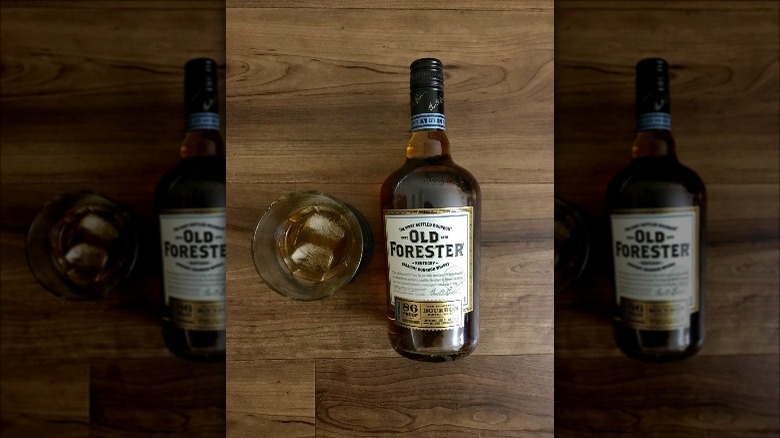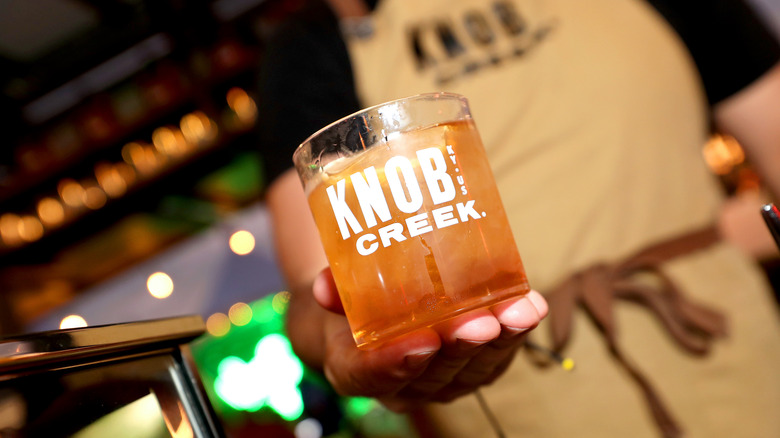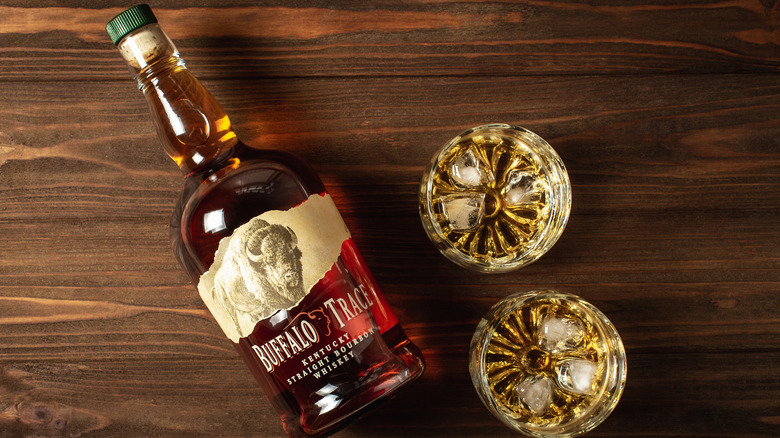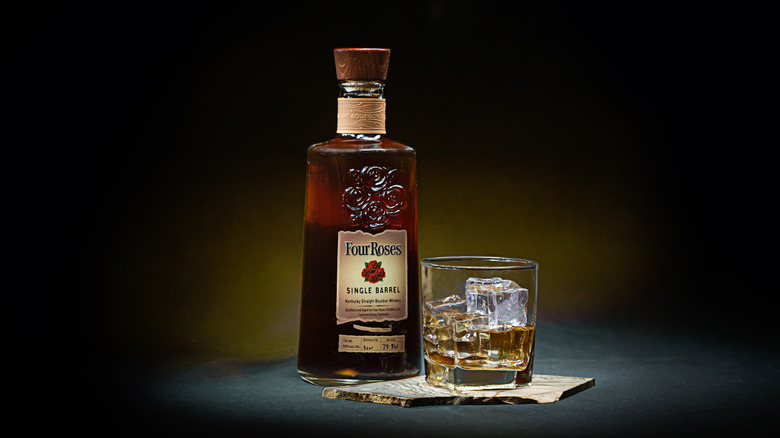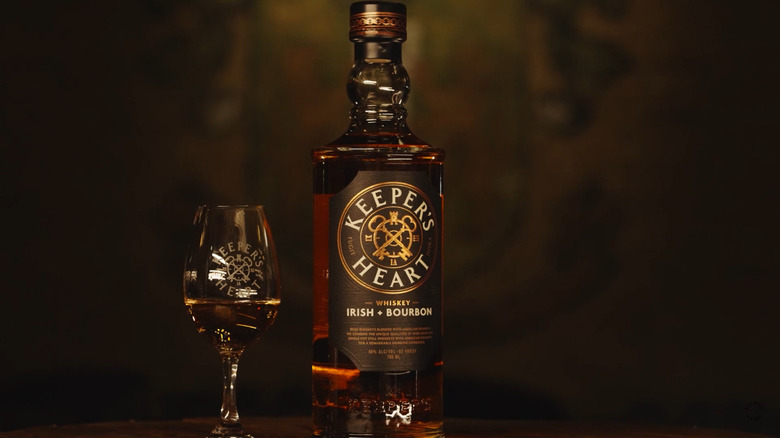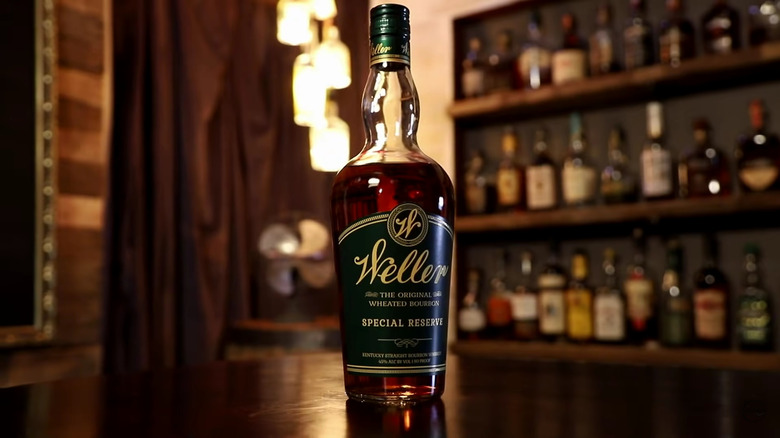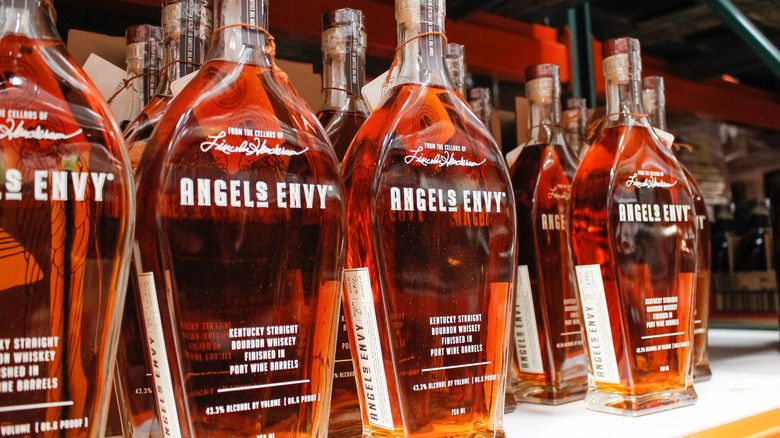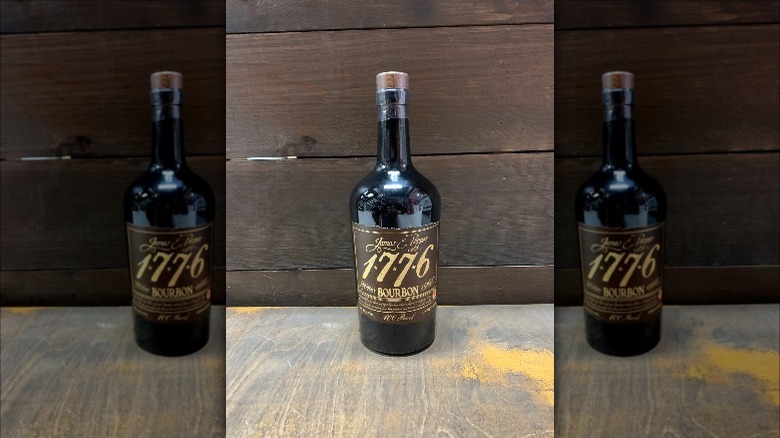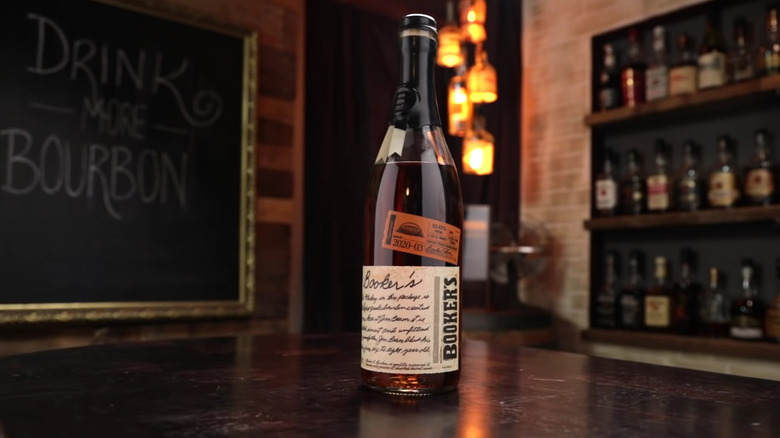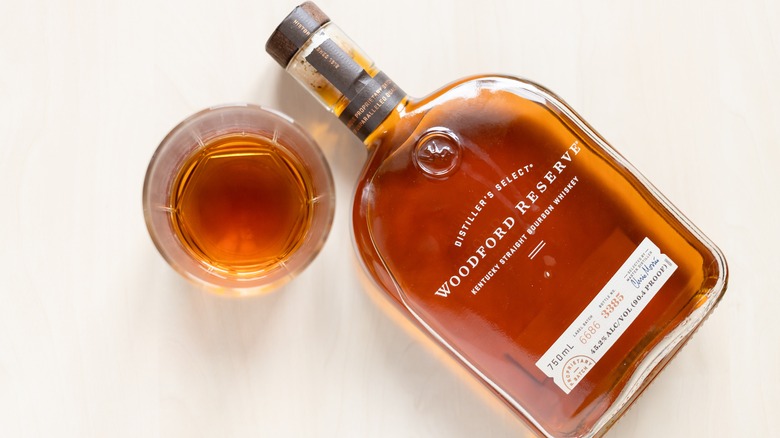10 Best Bourbons To Mix In A Manhattan Cocktail Ranked
The Manhattan cocktail is nothing short of a bartending classic. It's got some serious history, for one, given that it has been satisfying thirsty patrons since the late 19th century. That's when it was supposedly invented by a mysterious unnamed bartender in New York City (per Taste Cocktails). Although the earliest recipes did not specify the type of whiskey used by this quasi-mythical mixologist, many assume that rye whiskey was employed due to the spirit's prevalence around New York City at that time, according to the New York Times.
However, rye whiskey can be divisive. This peppery spirit can sometimes prove to be overpowering for those with gentler tastes. As a result, bourbon, a whiskey made predominantly from corn, has long been used as a replacement for rye whiskey. Its sweeter and more mellow flavor profile can be a grand introduction to whiskey, especially in a classic cocktail like the Manhattan.
Bourbon has rapidly been growing in popularity in the United States, with 2020 production reaching heights not seen for decades (per VinePair). New bourbon buyers quickly learn that there is an enormous range of bourbons currently available, with a still-growing number of distillers (via IBISWorld), which makes selecting the correct bourbon for a fantastic Manhattan all the more difficult. To save you a non-hangover-related headache, we ranked some of the best bourbons to use when mixing a Manhattan, incorporating a range of widely differing spirits to ensure that you can make a Manhattan that suits any and every palate.
10. Old Forester Bourbon 86 Proof
Old Forester is a historic brand known for products that are enjoyed as much now as they were in the era before Prohibition. Although so-called heritage brands like this one do benefit from positive consumer associations (per Terry News), Old Forester has also remained popular due to its commitment to excellence. From being the first bourbon made available exclusively in glass bottles (via American Whiskey) to the continued commissioning of handcrafted barrels designed specifically for the brand's bourbon (per CultureMap Dallas), this dedication has always been present. Ultimately, this results in a bourbon that is a reliable classic, perfect for a variety of uses that also includes a starring role in a Manhattan.
However, it may be a bit strong for some, as Old Forester's mash bill consists of 72% corn, 18% rye, and 10% malt (per Tesco). This relatively high rye content lends the bourbon a fiery character that some can find overwhelming. To be fair, a Manhattan cocktail benefits greatly from the inclusion of a high-rye bourbon, so it may still be worth a try — so long as you know what you're getting into.
While Old Forester's spicy kick is often the main reason mixologists pluck it from the shelf when making Manhattans, it is not the only one. As Erin Petrey, cocktail editor of Bourbon & Banter explains, Old Forester carries other flavors which make it highly suited to the popular cocktail, especially notes of cherry (via Drink Hacker).
9. Knob Creek Single Barrel Reserve
Single barrel bourbons are, as the name implies, bourbons that are drawn from one barrel only. By not blending multiple barrels together (as is often the practice in the industry) producers sacrifice a certain degree of consistency. However, single barrel bourbons do highlight and thus celebrate the uniqueness of each batch. These differences occur in spite of recipe, aging times, and barrel types all being kept nearly the same, as a range of chemical and physical processes occur in aging process that are not controllable or directly replicable (via Paste).
Because of all this, single barrels are something of an unknown quantity, making them an exciting gamble that entices consumers to buy the same bourbon from different batches. Yet, that variety also means that they might be a risky business for those with picky taste buds.
However, Knob Creek's single barrel has some trademark attributes that make it well-suited for Manhattans. If you're feeling adventurous, they could still be worth the potential risk. First, Knob Creek comes in at 60% ABV. This means that the spirit packs a great deal of flavor into a glass (via Breaking Bourbon). What's more, as reported by Malt, this bourbon is extremely multifaceted, with a variety of aromas, tastes, and mouthfeels presenting themselves in each sip. When mixed into a Manhattan, this complexity adds layers to the cocktail, whilst also ensuring the cocktail's overall profile is not dominated by powerful mixers.
8. Buffalo Trace
Given that it's relatively cheap and is produced on a large scale, as per The Spirits Business, Buffalo Trace has became a seriously popular bourbon. Even so, it's still somewhat hard to find (via The Whiskey Shelf). Still, if you can manage to procure it, you could do worse than to incorporate Buffalo Trace into your next Manhattan.
Buffalo Trace is especially popular due to its earthy tasting notes, which can be used in conjunction with a dazzling array of ingredients. This was exemplified at the Buffalo Trace's notoriously challenging cocktail competition, known as the Mystery Migration. According to tasters downing the bourbon at the event in the London heat, the range of flavors in the liquor was stunning and included oolong tea, peanut butter, and beetroot (per The Cocktail Lovers).
Fortunately for non-professionals, Buffalo Trace can be enjoyed in plenty of accessible mixed drinks, including the Manhattan. The woody nature of the spirit is amplified nicely in the cocktail. With its very agreeable price point, Buffalo Trace is often the spirit mentioned by major food publications, too. As if that weren't enough, adding Buffalo Trace to your liquor cabinet also opens the door for experimenting with different styles of the cocktail, such as the Black Manhattan. Made by replacing the sweet vermouth with amaro (via VinePair), the Black Manhattan is a cocktail that celebrates earthy, herbaceous flavors. With its unique flavor profile, Buffalo Trace is a natural bourbon for the unique Black Manhattan.
7. Four Roses Single Barrel
According to Epicurious, Four Roses Single Barrel boasts a mash bill with one of the highest rye contents in the industry. This mash bill, when combined with the spirit's impressive 50% ABV, would lead many to expect Four Roses Single Barrel to be a very intense mouthful. Yet, this bourbon is known for being extremely approachable, well-rounded, and smooth (via Four Roses).
Difford's Guide suggests this approachability is due to the yeast used by Four Roses, which is a noticeably fruity strain that may help balance out the peppery rye. Others believe that the oft-lamented process of chill filtering — a procedure wherein the bourbon has chemical compounds removed, according to Whisky Advocate — leaches some flavor from the bourbon, making it more palatable to newbies or those with sensitive palates (via Liquor).
In terms of Manhattan-making, Four Roses Single Barrel doesn't adhere to expectations. Instead of producing a spicy cocktail, the spirit is creates delicate Manhattans with hints of honey, peach, and herbs (via First Pour Cocktails). The resulting cocktail, though of considerable strength, is very easy drinking. Using Four Roses Single Barrel in a Perfect Manhattan (a variation of the cocktail which uses equal parts sweet and dry vermouth) allows the bourbon's flavors to really come to the fore while also keeping the cocktail from becoming overly sweet.
6. Keeper's Heart
Keeper's Heart is perhaps the most contentious entry here. That's not because the spirit's quality or flavor is lacking — it certainly has many happy customers. Rather, it's the source of a few arguments because Keeper's Heart is technically not a bourbon. Yet, it could still deserve a place in your liquor lineup, especially when you're hankering for a Manhattan.
Made by the O'Shaughnessy Distilling Co., Keeper's Heart is a blended whiskey made from triple-distilled Irish Whiskey and bourbon. The result is a unique spirit which, though bourbon-dominant, still borrows many flavors from its whiskey component. According to master distiller Brian Nation, "If we're trying to attract bourbon drinkers to our whiskey, they're loyal to that style. So I think we found one that has a pepperiness in the initial kick, plus the caramel and oak, but it's enhanced by the herbal notes of the pot still, with a kick of butterscotch from the grain whiskey." (via InsideHook).
This unique spirit promises to produce a hitherto-unseen Manhattan, which would be reason enough for many to try it. If you need more convincing, the mixture of flavors present in Keeper's Heart, which include vanilla and espresso (as per Robb Report), are likely to turn the classic cocktail into a winter warmer. While there are surely purists who shudder at the suggestion, a completely new take on the Manhattan cocktail could be well overdue. Keeper's Heart seems to be the spirit primed to make that change.
5. Weller Special Reserve
Just as some bourbons come with a high proportion of rye, there are those that favor a mash bill that heavily utilizes wheat. These two bourbons differ wildly, with wheat imparting sweet flavors and a smooth mouthfeel which many bourbon novices find much more appealing, according to Bourbon Classic. That isn't to say aficionados don't like so-called wheated bourbons. In fact, perhaps the most critically acclaimed bourbon of all time, Pappy Van Winkle Family Reserve, is made with a heavily wheated mash bill (via Robb Report). Though it's clear that Weller Special Reserve is no Pappy Van Winkle, it still carries all the hallmarks of a good wheated bourbon with little to no harshness and plenty of sweet flavor notes, as Breaking Bourbon notes.
Bourbons of this nature tend to go well in Manhattans, as long as a sweeter version of the cocktail is what you are after (via First Pour Cocktails). For those looking for a classic peppery Manhattan, a wheated bourbon simply isn't going to fit the bill, no matter how good it is.
Competition in the wheated bourbon and whiskey marketplace is growing, with brands such as Maker's Mark and Woodford Reserve gaining increasingly wide fanbases (per Bloomberg). It's safe to assume that this increasing demand for wheated bourbons will be reflected in cocktail sales, meaning that wheated bourbon cocktails will possibly be the whiskey-based drinks of the future.
4. Angel's Envy Kentucky Straight Bourbon
Angel's Envy is a bourbon jam packed with flavor. This is not a surprising fact when you learn the person behind Angel's Envy is Wes Henderson, son of the legendary Lincoln Henderson, the masterminded behind the rise of Woodford Reserve (per Whisky Advocate). In the making of Angel's Envy, Wes Henderson has gone to great lengths to maximize taste. Most notably, Angel's Envy enters the bottle nearly completely unfiltered. According to Kyle Henderson, grandson of Lincoln, "We use an 80-micron stainless steel screen to remove the large chunks of char, and that's it. There's no active charcoal and we never chill filter" (per Angel's Envy).
This method can give Angel's Envy a cloudy appearance with sediment collecting at the bottom of the bottle. Yet, even if that makes you look twice, this seems a small cost for the flavor. Indeed, Angel's Envy prioritizes flavor so highly that the bourbon is even finished in barrels that used to hold port, a type of fortified wine (via Angel's Envy).
The finished bourbon has received fantastic reviews with many lauding the spirit's complex yet subtle nature (per Paste). If used correctly, Angel's Envy can produce a pronounced bittersweet flavor In Manhattans, adding a luxurious feel to all versions of the cocktail whether they be classics or new interpretations (per Distiller).
3. James E. Pepper 1776 Bourbon
James E. Pepper 1776 is another bourbon with an extremely high rye content, with the grain making up 36% of the mash bill, according to James E. Pepper. Not only is this bourbon high in rye, but it also goes largely unfiltered in a similar process to Angel's Envy. To top it all off James E. Pepper 1776 is a strong bourbon, coming in at 50% ABV. On paper, all these factors would indicate a harsh, powerful spirit, one which bourbon novices would struggle to appreciate. In reality, the story is somewhat different. Here, the predominant tasting notes are sweet and slightly spicy, with a balanced hint of burnt caramel (via Whiskey Consensus).
This is a highly coveted flavor profile, with the bourbon being presented a double gold award at the highly prestigious 2021 San Francisco World Spirits Competition (per James E. Pepper). While James E. Pepper 1776 is evidently a very sippable bourbon, it performs exceedingly well in a range of cocktails, including the Manhattan, thanks to the spirit's generously spiced finish (per Whiskey Consensus). The bourbon's suitability for mixing should come as little surprise given that the brand's founder, James Pepper himself was known to enjoy a cocktail. He's even been credited for popularizing the Old Fashioned cocktail, according to the New York Times.
2. Booker's Bourbon
Booker's Bourbon is at the cutting edge of small-scale, cask-strength bourbons with its highly anticipated but irregularly released batches (you can expect about four per year). The public's eagerness to scoop up Booker's Bourbon is largely due to the immense levels of variability you get from batch to batch. The differences present between bottles means it is highly advisable to do some homework before purchasing a bottle of Booker's Bourbon, thus ensuring the liquid inside matches your taste. Booker's aims to accommodate this research process by providing a wealth of information about each batch, down to exactly where the barrels were aged (per Booker's).
Though it's pretty expensive, Booker's Bourbon validates its price tag with a variety of intense flavor notes, from roasted graham crackers to tobacco (via Paste). This is a strong, powerful, undiluted, and unfiltered bourbon, usually landing between 61 to 64% ABV (per Booker's). When incorporated into cocktails Booker's asserts itself both through flavor and alcoholic strength, two factors which have endeared it to many a mixologist, such as Animae bartender Anthony Belculfini. "I would ask for a Booker's Bourbon Manhattan," he told VinePair. "Two ounces of overproof bourbon mixed with an ounce of Carpano Antica Vermouth will certainly send you on your way with a taste of the buzz you've been providing your patrons with all night."
1. Woodford Reserve Kentucky Straight Bourbon
Consistently rated as one of the best bourbons out there, Woodford Reserve Kentucky Straight tops our list thanks to its near-miraculous balance of over 200 flavor notes (per Woodford Reserve). Key to making such a diverse flavor profile palatable is Woodford Reserve's smoothness, thanks to an arduous triple distillation process (via Whisky Advocate). This balance led Woodford Reserve to become one of the most celebrated bourbons in the world, winning a double gold at the San Francisco World Spirits Competition. The brand was also named World Whisky Brand Champion 2021 (per The Spirits Business).
While it's a fantastic bourbon, Woodford Reserve is also generally easy to find and relatively cheap (via Bottled Prices). This negates the heartache many people experience when using precious, hard to locate bourbons for cocktails. The bourbon itself is uniquely suited to Manhattans, a fact embraced by the company. Woodford Reserve runs an annual Manhattan competition which sees competitors put a new Woodford Reserve-inspired spin on the classic cocktail (per Whiskey Raiders).
Speaking to Chilled, distiller Chris Morris explained why the Woodford Reserve-Manhattan combination works so well. "It's only natural that a bourbon as well-crafted as Woodford Reserve is used in such a unique, and not to mention delicious Manhattan recipe," he said. While new versions of the Manhattan will always excite, you would be hard pressed to beat a classic Manhattan made with the delicious spirit that is Woodford Reserve Kentucky Straight Bourbon.
